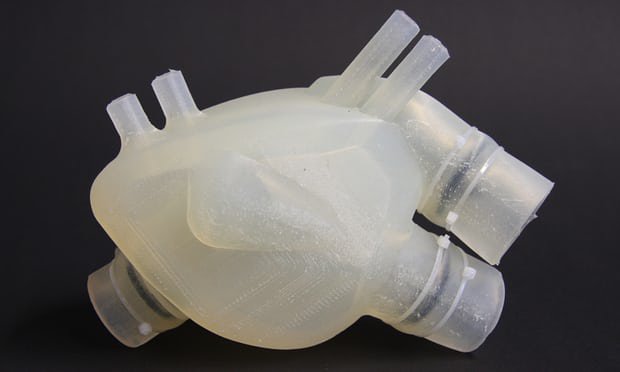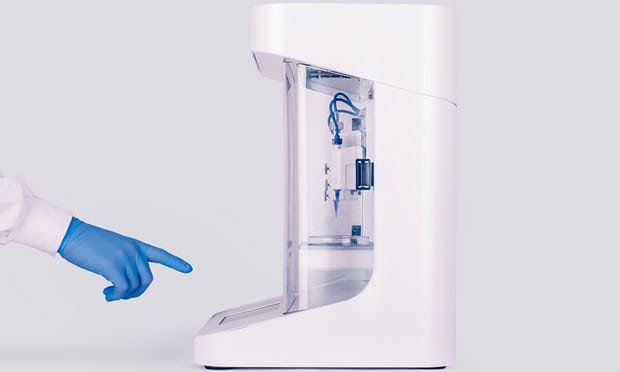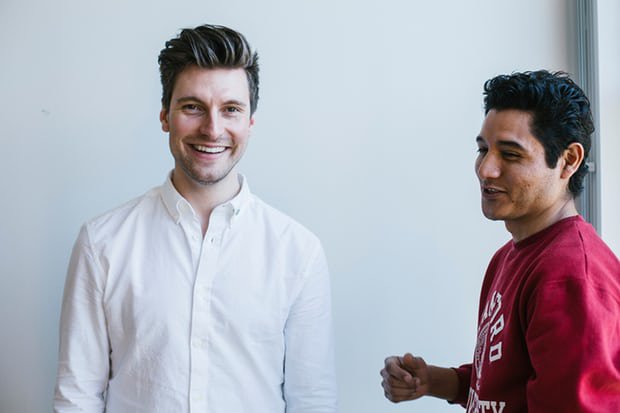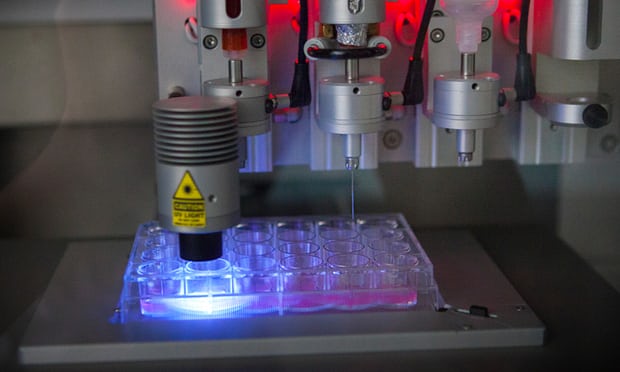 3D printed siliceous heart developed by engineers at the Federal Institute of Technology in Zurich
3D printed siliceous heart developed by engineers at the Federal Institute of Technology in Zurich Sina Technology News Beijing time on October 1st news, according to foreign media reports, in recent years, scientists have vigorously developed 3D printers for 3D printing to manufacture human organs, although the possibilities of this technology are exciting, but scientists I began to worry that 3D printers would make humans "play the role of God." At present, Tim Lewis, the author of the Guardian column of the Guardian, has written an in-depth analysis of the current status and future prospects of 3D bio-printers.
Scientist Erik Gatenholm first saw the 3D bioprinter in early 2015, and his father Paul Katoholm was professor of chemical and biopolymer technology at Chalmers University of Technology, Gothenburg, Sweden. His father bought him a bio 3D printer for about $200,000. At that time, Eric’s father said with amazement, “Is this thing capable of printing human organs?†Now Eric recalls this scene. He still feels amazed. He said: "This thing can also print human organs, it is simply nonsense!" But soon the device printed a small cartilage, although it is not really cartilage tissue, but it is very close in appearance. It feels like a piece of cartilage. At that moment, I think this bio-printer is so cool!
Eric, who owns a 3D printer, had long wanted to do something in the field of 3D bioprinting. He grew up in Sweden and the United States. His father was a visiting professor in the United States. Eric was full of confidence when he was young. When he first established his first biotech company at the age of 18, he realized that if the device could print human organs, as his father said, it had the potential to revolutionize the medical industry.
Organ transplants for life-saving are very scarce all over the world. For example, kidney transplants in the National Health Service (NHS) in the UK require an average of 944 days for patients to wait for a human organ transplant. More than two and a half years, similar shortages It also occurs in the liver, lungs and other organs. In the United States, the lack of transplanted organs may be the number one cause of death in US patients. About 900,000 people die each year in the United States, and one-third of all deaths are caused by receptor rejection or time delays in organ or engineered tissue transplantation. It is conceivable that the current demand for transplanted organs is very large.
 As shown, the Cellink 3D bioprinter is less than one hotel mini fridge.
As shown, the Cellink 3D bioprinter is less than one hotel mini fridge. The emergence of bio-ink
Eric's father introduced him to Héctor MartÃnez and Ivan Tournier, Hector and Ivan were both Eric's fathers, 27 Eric, who is old, said: "I talked with them about some experiments. I mentioned why I didn't buy printing ink online?" Ivan said, "There is no printing ink on the Internet, you can't buy it." Eric said suspiciously: "What does this mean? This is the most stupid thing I have heard. There are a lot of printers on the market. It should be very easy to buy ink." Ivan said: "You didn't understand me. You can't buy ink on the Internet, you need to make it yourself, you need to add some substance to the print ink." Eric said: "Well, I will make my own ink!"
Cellink was born in January 2016. Although the technology is part of science fiction, its business philosophy is similar to the classic "razor and blade." In this long-established business model, the razor is actually given out, and then profitable on the adjustable blade. The same is true for inkjet printers, where the user needs to replace the ink cartridge multiple times.
In the field of bioprinting, Eric and Hector developed the world's first standardized bioink, which is made primarily of nanocellulose alginate, a substance extracted from seaweed. If you have a 3D bio printer, you only need to buy this finished ink directly.
Bio-ink has great influence, especially considering that it was born soon. Its commercial companies have won many awards, such as: Innovation Award, Best Entrepreneur Award, etc. At the same time, Bio-Ink also won the Swedish version of “Longxue Venturesâ€. Funding for the "Reality Show" program. Only 10 months after the release of bio-ink, the company founded by Eric entered the stock market and was listed on the Nasdaq Stock Market. The initial public offering was oversubscribed by 1070%.
 The picture shows Cellink partners Eric and Hector
The picture shows Cellink partners Eric and Hector When author Tim met Eric in Gothenburg, Sweden, Eric seemed to be still thinking about how to use the company's latest liquidity. Frankly speaking, Eric's office was very chaotic. There was a piece of iron on the ground, and the suit jacket was hung. On the wall nails, this jacket facilitates his attendance at the client meeting of the temporary arrangement. Usually he and 32-year-old Hector work 16 hours a day, Eric smiled and said: "This sofa is very suitable for sleeping, lying comfortable." In fact, Eric's office has no place to sit down, creatures The ink project team was expanding too fast, and Eric gave his chair to the new employee. He smiled and said, "I donated it to science."
But Eric is very clear: it is the era of bioprinting. He said: "As an entrepreneur, you always look for the blue ocean. Entrepreneurs always ask: 'Where is there a new field that makes you synonymous with it? Can you occupy this new field?' I think bio-ink And bio-printing technology is this blue ocean."
Eric shook his head in disbelief and said: "No one has ever made bio-ink!"
Bioprinting is a surreal concept that Eric is happy to accept, but bioprinting can also raise certain ethical issues. It works like a common 3D print: initially you can use a computer program to create a virtual form structure, and then use the printer to gradually print the finished product, sometimes in advance with a scaffolding, and finally print. But bioprinting is different from printing jewelry, figurines, or car parts, and bioprinting technology potentially forms living tissue.
Initially, this could be to print skin or cartilage, which are relatively simple structures, and it is very clear that they can grow outside the body. However, pioneers in bioprinting technology believe that they can print and manufacture complete organs in the future, such as the heart and liver, to create a complete organ from scratch, and even for human organ transplants.
Global development of bio-printing technology
At present, scientists and commercial companies all over the world have been involved in bio-printing technology. In fact, in a sense, some kind of competition has already started. Organic in San Diego, USA, has entered the field of bio-printing since 2007. The company has successfully printed part of the lung, kidney and heart muscle tissue. In 2015, Organ Innovations announced that it has partnered with cosmetics giant L'Oreal to provide 3D printed skin with the ultimate goal of eliminating the need for animal experiments.
L'Oréal is investing heavily in research and development of bioprinting projects. In September 2016, the company revealed that the company's scientists have established a partnership with French company Poietis to create synthetic hair follicles. It is reported that the project is actually very complicated, each hair follicle contains 15 different types of cells, which is a cyclic process of fiber manufacturing, which requires catalytic stimulation in a test tube.
Many people have tried in this regard and eventually failed. But L'Oréal and Poietis believe they are approaching the attack. The key is the bioprinter developed by Poietis. Most machines squeeze bio-ink through nozzles, and they use lasers to store cells one by one, dropping 10,000 drops per second without damaging the cells. Fabien Guillemot, Poietis' chief scientific director, explained in a collaboration video that by continuously layering cell droplets on a surface, it can print out a 3D structure that can be used for Print biological tissue.
 The picture shows the RegenHU 3D bioprinter developed by the Department of Applied Science at the Zurich University of Technology.
The picture shows the RegenHU 3D bioprinter developed by the Department of Applied Science at the Zurich University of Technology. Poietis calls its innovative technology 4D bioprinting, Eric said: "The fourth dimension is time, because our laser-assisted bioprinting technology can basically print only one cell at a time, which will enable us to guide cells and the environment. Interactivity until they form the biological function we want."
In the short to medium term, L'Oréal hopes that the sunscreens and anti-aging essences they make will be more effective, because these products can be tested repeatedly on human-like printed materials, perhaps in the future, L'Oréal's new shampoo will Make people's hair more shiny and beautiful. But it is obvious that the impact of such technology may be far from the supermarket's cosmetics sales area.
If the skin can be printed in the laboratory, it is not difficult to imagine that this printed skin can be used to treat the skin of patients with severe burns. Currently, skin graft surgery is the most common treatment for skin burns, but bleeding and infections occur during treatment and usually take a long time to recover.
At the same time, the development of synthetic hair follicles seems to open up new ways to reduce hair loss or transplant commercial products. According to José Cotovio, research and innovation department at L'Oréal, it is clear that our future goal is to test innovative molecules using hair follicle systems made in test tubes and to improve our hair aging, hair loss, and Understanding and understanding of key processes behind phenomena such as hair growth.
This is only the tip of the iceberg. At present, other researchers are actively studying how to make human organs. Eric said: "Bioprinting will bring great benefits to human beings. Some people die because of organ failure, which is the cause of their death. If we can replace these depleted human organs and perhaps extend human life, that would be great!"
There are still some gaps in our achievement of the above goals, but not far away. Eric believes that bio-printed skin may still be available in five years. Within 10 years, we will begin to see some cases of cartilage implants, which may be partial cartilage or whole cartilage implants. He smiled with confidence and said: "3D printing human organs can be achieved in our lifetime!"
Inevitably, bioprinting can create ethical issues, including: people's fear of the quality and effectiveness of artificial skin and 3D printed implants, and condemning bioprinting technology to "play the role of God." For these negative effects, the most comprehensive survey report may be conducted by a team of science and innovation research departments at the University of Edinburgh, UK.
The project leader is Niki Vermeulen and Gill Haddow, whose research team is not afraid of monsters like creatures in Frankenstein, they say "If God exists, God can create and influence life, then there are now many technologies that enable humans to play the role of God, such as genetics. Bioprinting technology can help people make smaller human organs for medical use. application."
The bigger obstacle that 3D bioprinting technology needs to overcome is the cost issue. Although this technology brings hope to people, the artificial organs manufactured may solve the long-term queuing problem of organ transplant patients, but for now, this hope is difficult to achieve. 3D bioprinting is a costly technology, and if it can be achieved, it is a small number of people who can afford the relevant costs. Nicky warned that the current health differences and medical treatments around the world will make many people unable to share 3D bio-printing organs.
In short, they concluded that organ transplant patients in other systems such as the UK National Health Service and the US Health Assurance System are facing surgical problems and organ delays that will support the continued advancement of bioprinting technology. You might think that exporting relatively cheap bio-printers to certain countries and regions where health care is imperfect can give patients the latest technology, but in fact, these 3D bio-printers can only be used Ability to use their sound health care system.
 The picture shows the tough plastic cells made by RegenHU 3D bioprinter.
The picture shows the tough plastic cells made by RegenHU 3D bioprinter. Strive to reduce costs
Cost has become the "roadblock" in the early days of 3D bio-printing. The best printer brands, such as EnvisionTEC's 3D Bioplotter and RegenHU's ​​3DDiscovery, are all priced at more than £150,000. Therefore, these printer brands can only be seen in college laboratories. At present, Eric hopes that Cellink can change this situation. Although Eric's company started out as a bio-ink, it took a long time to enter the printer hardware market. Eric’s desk is next to “Bobâ€. He named his pet Inkredible+ 3D bio-printer, which was independently developed by Eric and is often exhibited at various trade shows.
Inkredible+ is a very attractive printer: it's slightly smaller than the small fridge in the hotel room, with a white design and blue LED lighting, but what really appeals to customers is that it's not expensive. Cellink has built three 3D bioprinters ranging in price from £7,600 to £29,900. Eric explained that they were able to save on manufacturing costs, in part because they used cheap 3D printer components instead of the costly motor rail system. In addition, this is in line with the "razor and blade" business model, Cellink understands that the more customers with 3D bioprinters, the more bio-inks the company sells.
Eric is very proud of his company because it can reduce the cost of 3D bio-printers. The company's customer base now includes: Massachusetts Institute of Technology, Harvard University, University College London, and other universities. This new technology is available to 3D printing amateurs. Eric doesn't know how customers use their printers and inks. Maybe they're printing "biological tissue" test drugs, or extracting cells from cancerous tumors, then researching various ways to try and finally find the best treatment. It is the true meaning of this technology.
Eric said: "Because our 3D printers have reduced costs, some large bio-printing companies are very dissatisfied with this, but to be honest, consumers are the driving force behind the market, they want to buy cheap products. For us Well, we don't know where to cure cancer. I don't know if it will appear in India, Japan, South America or New York, but we want to give everyone the opportunity to study and experience."
Print the challenges facing the human heart
In addition to the geometry, the most complex organ of the human body is the heart. It does not carry out complex biochemical reactions like the liver and kidneys. Scientists work very well. The heart is different from other organ tissues such as the brain. For this reason, the heart is theoretically the most easily bioprinted human organ. First, it is very suitable for bioprinting. Currently, 3,500 people in Europe are awaiting heart transplants, many of whom have been waiting for a new heart for more than two years.
How do we bioprint a heart? The most promising method at present is bio-printing cell scaffolds, which are used first to print biodegradable cardiac scaffold structures, which is equivalent to a "cytoskeleton." This scaffold simulates the extracellular matrix of the heart, which provides structural support to the cells and helps guide them to the appropriate areas. Next, the heart cells will be printed on the scaffold. Inside the scaffold, the cells interact with each other and link to form the structure of the heart. After the cells fuse into the entire structure of the heart, the scaffold can be dismantled and left for transplantation. Full-featured heart. At present, this technology has emerged. Although its application range is limited, a stent has been used for bioprinting a small piece of myocardial tissue, which has been proven to repair damaged heart tissue in heart disease mice.
Why are we still not printing the heart directly? Bioprinting a small piece of muscle and creatures printing whole heart tissue is a completely different thing. Why? One problem is the need to solve - blood vessels. At present, biological printing is difficult to manufacture blood vessels, not to mention that for a complex heart tissue, it contains capillaries smaller in diameter than the smallest cells. Printing and manufacturing the vascular system is not an easy task. NASA even provided $500,000 in funding to reward the first 3D printed vascular tissue research team, NASA-sponsored the Vascular Tissue Challenge, which plans to The funds were awarded to a 1 cm thick human vascular tissue with a full-function blood system that survived for 30 days in a test tube.
How far are we from biological printing of human organs? There are various predictions in the assessment of when human organ bioprinting is achieved, and one research team claims that they can bioprint a heart within six years. At present, no one knows that bioprinting technology can safely be used for the exact time of human organ transplantation. However, considering the large number of scientists currently engaged in 3D bioprinting, and expecting the bioprinting field to exceed $1.3 billion in 2021, perhaps we are not far from achieving the heart of 3D printing. (å¶å€¾åŸŽ)
(Editor)
facial care,home use beauty device,portable beauty device,facial beauty equipment,2022 beauty device, face cosmetic equipment
Zhongshan Seven Cool Electronics Technology Co.,Ltd , https://www.gdsevencool.com